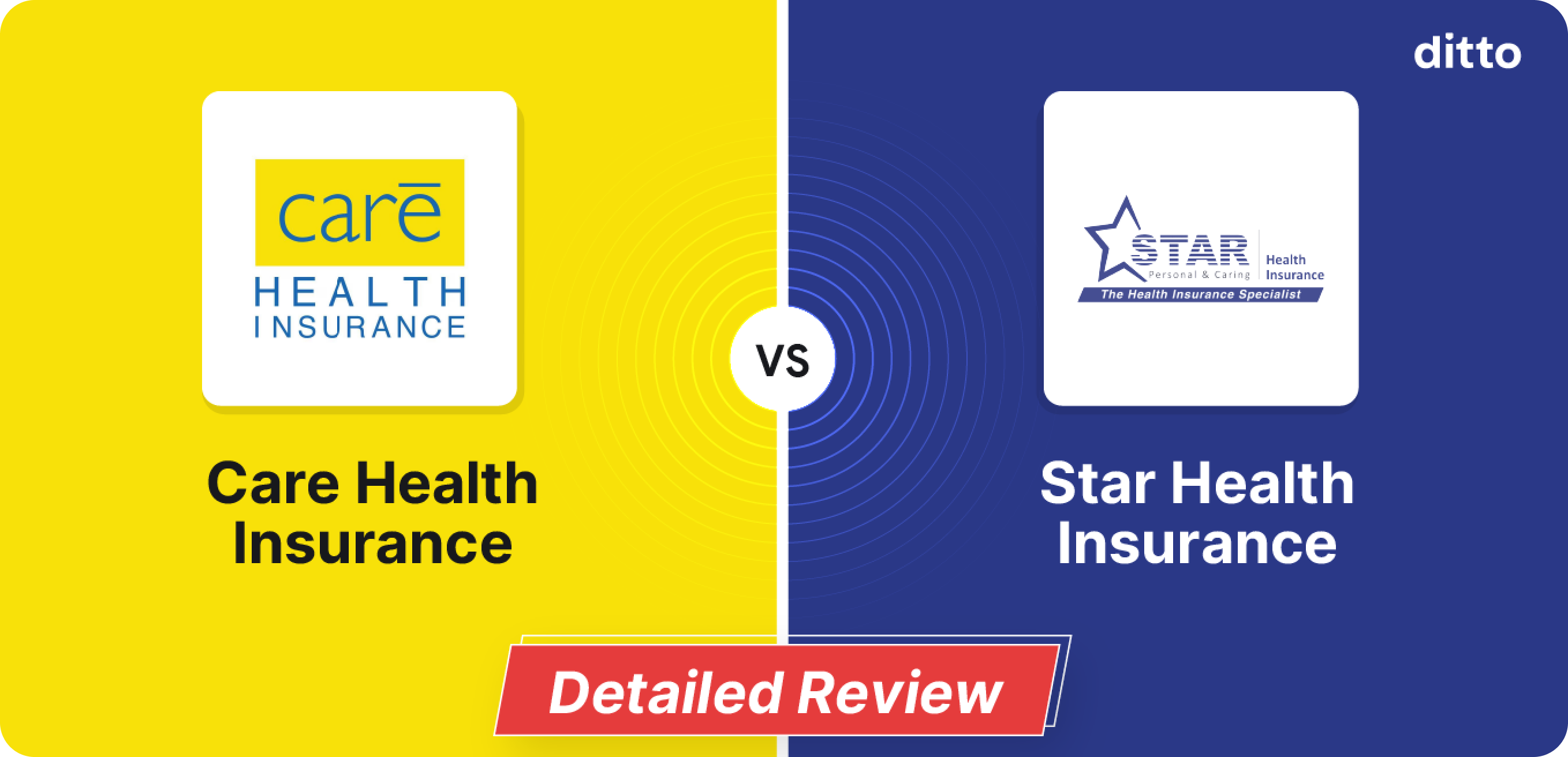Care Health Insurance vs Star Health Insurance
Care Health Insurance offers a better claim settlement ratio (93%), lower complaint volume, and efficient claim handling, making it the preferred choice for smoother claims and reliability.
Star Health Insurance stands out for its larger hospital network (14,000+) and wider coverage, but has faced higher complaints and operational concerns in recent years.
Introduction
If you’ve been researching health insurance, you’ve likely come across Care Health Insurance and Star Health Insurance. Both are trusted, long-standing players in the industry, known for their wide coverage and dependable claim support.
Still, when it comes to choosing between them, the details matter, how smooth their claims are, how wide their network is, and which one offers better value for your money. We’ve analyzed their claim data, policy features, and customer experience to help you understand how Care and Star compare, so you can decide which insurer fits your needs best.
Friendly reminder: It’s easy to get lost comparing policies and premiums. Instead of spending hours on it, why not get personalized insurance advice from Ditto? We offer free consultations with zero spam! Just 30 minutes to clarify all your doubts. So book a call now.
About Care Health Insurance
Care Health Insurance (formerly Religare) is one of India’s leading standalone health insurers, offering flexible, wellness-based health plans for individuals, families, and senior citizens.
What it Does: Founded in 2012, the company is recognized for its customer-centric products, digital-first approach, and in-house claim management, which enables quicker settlements.
Why it Matters: With a presence across 260+ branches in India and over 11,400+ network hospitals, Care Health ensures wide access to cashless healthcare across the country. Its add-on options like maternity, international, and wellness coverage make it suitable for diverse health needs.
Popular Plans: Care Supreme, Care Advantage, Care Ultimate, Care Freedom.
To learn more, visit our Care Health Insurance Review or see Care’s public disclosures.
About Star Health Insurance
Star Health Insurance is India’s first standalone health insurer, specializing in health, accident, and travel insurance.
What it Does: Established in 2006, Star Health is recognized for its dedicated approach to retail health insurance and excellent customer support. The company manages claims in-house for quicker settlements, giving customers direct assistance during hospitalization.
Why it Matters: With over 14,000+ network hospitals, Star Health ensures broad access to cashless treatment across India. Flexible plan options, higher sum insured choices, and policies tailored for families, individuals, and senior citizens make it a strong choice for diverse health needs.
Popular Plans: Star Super Star, Assure, Star Comprehensive, and Family Health Optima.
To learn more, visit our Star Health Insurance Review or see Star’s public disclosures.
Care Health Insurance vs Star Health Insurance: Key Metrics
The data shows that Star Health has a wider reach and higher business volume, while Care Health stands out with a better claim settlement ratio, lower complaints, and more efficient claim handling.
Care Health Insurance vs Star Health Insurance: Popular Plans
Care Health Insurance vs Star Health Insurance: Which Is Better For You?

Choose Care Health Insurance
If you value higher claim reliability, efficient service, and flexible coverage. With a 93% claim settlement ratio, lower complaint volume, and strong wellness benefits, Care is ideal for those seeking smoother claim experiences, coverage for pre-existing conditions, no room rent capping, and unlimited restoration for long-term protection.
Choose Star Health Insurance
If you prefer wider hospital access and comprehensive family coverage. With 14,000+ network hospitals and plans offering maternity benefits, AYUSH cover, and air ambulance support, Star Health suits families looking for extensive coverage and a strong in-house claim team across India.
Care Health Insurance vs Star Health Insurance: Ditto’s Take
Care Health Insurance shows strong reliability with a 93% claim settlement ratio within 30 days, backed by a solid network of over 11,400+ hospitals. Their flexible plans and customizable waiting periods make them a trusted choice, despite a moderate complaint volume.
Star Health Insurance, while having a wide hospital network and competitive products, recently faced a ₹3.39 crore penalty by IRDAI for cybersecurity lapses, raising concerns about operational stability. Their claim settlement ratio has dropped in recent years, accompanied by higher complaints, indicating challenges in claim processing.
Why Talk to Ditto for Health Insurance?
At Ditto, we’ve assisted over 8,00,000 customers with choosing the right insurance policy. Why customers like Arun below love us:

✅No-Spam & No Salesmen
✅Rated 4.9/5 on Google Reviews by 15,000+ happy customers
✅Backed by Zerodha
✅Dedicated Claim Support Team
✅100% Free Consultation
You can book a FREE consultation here. Slots are running out, so make sure you book your call now.
Care Health Insurance vs Star Health Insurance: Final Thoughts
While both insurers partner with Ditto, Care remains a primary recommendation due to better claim performance and customer experience. Star Health plans are suggested only with cautious consideration, preferably with expert assistance, due to current operational issues. You can learn more about how we evaluate insurers in this article: Ditto’s Cut.
FAQs
Which is better for family floater policies: Care or Star Health Insurance?
Both work well. Care Supreme offers a higher sum insured up to ₹1 Cr and unlimited restoration, while Star Family Health Optima is more affordable with wider network access and good value coverage.
Which insurer offers better claim experience: Care or Star Health?
Care Health leads with a 93% claim settlement ratio and fewer complaints, ensuring smoother claims. Star Health, though having a larger hospital network, shows lower settlement efficiency.
Does Care Health Insurance offer better maternity benefits compared to Star Health Insurance?
Star Health has broader maternity cover through the Super Star plan and add-ons. It covers normal and C-section delivery, pre- and post-natal care, newborn expenses from day one, and even IVF/ART treatments. Care Health offers maternity benefits under select plans, but with lower sub-limits and longer waiting periods.
Which insurer has a wider hospital network: Care or Star Health?
Star Health has a larger network with over 14,000 hospitals across India. Care Health also provides strong coverage with 11,400+ hospitals, ensuring good nationwide access to cashless treatments.
Last updated on:










